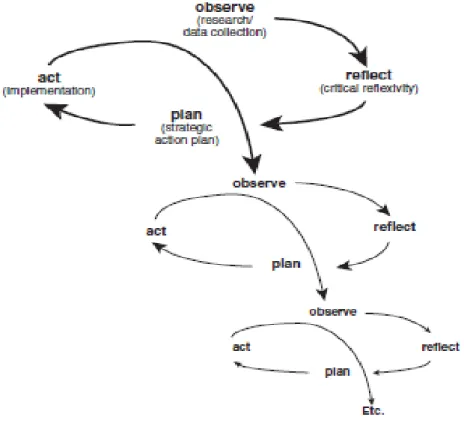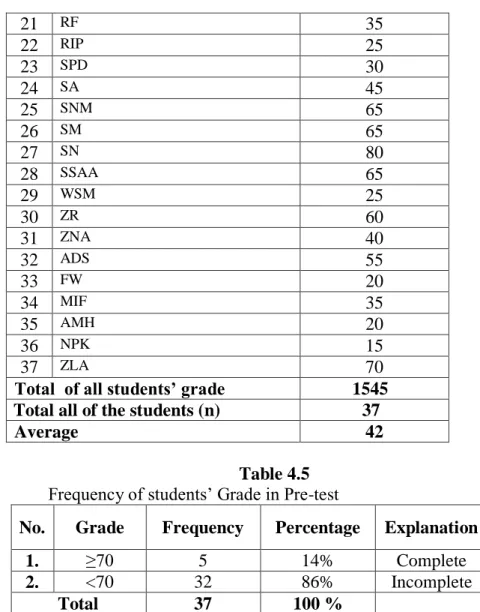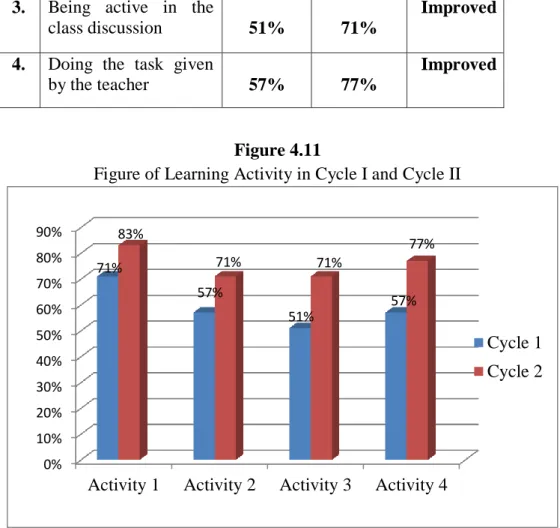The result of this research showed that Classwide Peer Tutoring Strategy (CWPT) had a positive result in improving the reading skill and learning activity of eighth grade students of MTs Ma‘arif 01 Punggur. Reading skill of eighth graders at MTs Ma‘arif 01 Punggur No Name of students Grade Final result criteria.
Identification Of The Problem
Based on the illustration above, the researcher considered improving the reading skill of eighth grade students of MTs Ma'arif 01 Punggur by implementing Classwide Peer Tutoring (CWPT) strategy. In this case, the researcher conducts classroom action research at MTs Ma'arif 01 Punggur using Classroom Peer Tutoring (CWPT) strategy.
Problem Limitation
Formulation The Problem
Objective and Benefit of Study 1. Objective of Study
This research is a way to help teachers in the process of teaching English, especially in reading ability. The application of this research is expected to assist teachers in creating favorable learning conditions so that learning objectives can be effectively achieved.
Prior Research
Skill language that the second previous research used is reading comprehension while the researchers investigated language skill is speaking skill. As for the difference between this research and the third previous research lies in language skills are examined and examples of research.
Reading Skill
- Reading Skill Models
- The Components of Reading Skill
- Indicator of Reading Skill
- The Assessment of Reading Skill
According to the Oxford Advanced learner's dictionary, skill is "the ability to do something well".10 In other words, it is an ability intended for an action that is useful and good. In contrast, if students cannot connect the information from the text to their background.
Classwide Peer Tutoring Strategy
- The Definition of Classwide Peer Tutoring (CWPT) Strategy Classwide Peer tutoring refers to situations in which one learner
- The Implementation of Classwide Peer Tutoring Strategy in Reading Instruction
- The Advantages of Classwide Peer Tutoring Strategy
- Disadvantages of Classwide Peer Tutoring Strategy
David Mitchell points out some teaching steps using whole class peer teaching strategy as follows23. Whole-class peer tutoring involves the use of nine components: (1) weekly competitive teams; (2) tutor-tutee pairs within teams; (3) points earned for correct answers; (4) a modeling error correction.
Action Hypothesis
A third potential disadvantage associated with the use of CWPT is related to the amount of content coverage possible between teacher-led versus peer-led teaching methods. A fifth potential drawback to the use of CWPT appears to arise from some general misconceptions about the role or function of such learning activities.28.
The Variable and Operational Definition of Variable
Independent Variable (X)
Dependent Variable (Y)
Operational Definition of Variable
Setting of the Research
Subject of the Research
The teacher chose one of her classes whose students had the lowest average grade in speaking. Based on the teacher's experience while teaching English subject reading, the teacher indicated that students are difficult in reading skills, precisely Classwide Peer Tutoring is the solution to the problem to make students better.
Action Plan
Furthermore, the researcher also collects the data from the post-test and results of student's activity. Furthermore, the researcher also collects the data from the post-test and the result of student's activity.

Data Collecting Strategy
Documentation may relate to specific individuals, such as school records and student reports, or may relate to more "macro" issues, such as Her Majesty's Inspectorate reports on the physical condition of schools. It can have a number of features. 38 For example, they may consist only of written words, or they may contain statistics, such as in a research report. In this case, the researcher needs documentation to get the full details of the founding history of MTs Ma'arif 01 Punggur, the organizational structure of MTs Ma'arif 01 Punggur, the names of teachers in each subject, the details of the outline of the school building to know the location of each class, office, library, canteen, mosque, parking lot and yard.
Instrument of the Research 1. Reading Test
To observe the learning activity and each cycle, the researcher used observation sheets. Reactions to particular students, optimally productive pairs and groups in the classroom are more vocal, etc.
Data Analysis
Tabular presentation of test results, finding the mean value of pre-test and post-test.
Indicators of Success
- Description of Research Location
- Vision of school: “The realization of students who believe, have science, Islamic character, and are able to compete nationally and
- Missions of school
- Description of Research Data a. Description of the Research
- Pre-test activity
Can class-wide peer teaching strategy improve the students' reading skills at the eighth grades of MTs Ma'arif 01 Punggur?, Can class-wide peer teaching strategy improve the learning activities at the eighth grades of MTs Ma'arif 01 Punggur?. MTs Ma'arif 01 Punggur is one of the educational institutions under the foundation of the Muslim hostel. MTs Ma'arif 01 Punggur stands on the land width 1 (ha), in Sidorahayu, Sidomulyo town Punggur sub district, Lampung Tengah regency.
Since 2018 MTs Ma‘arif 01 Punggur led by Mr. Langgengno Karma, B.Sc. as principal. a) The school's profile. GALIH INDRA P, S.Pd INDAH KUMALA S, S.Pd. f) Location sketch of MTs Ma'arif 01 Puggur Denah locality MTs. The action of this research used Classwide Peer Tutoring (CWPT) strategy to improve students' reading skills. 1) Pre-test activity.
Source: The students' reading grade pre-test at the tenth grade of MTs Ma'arif 01 Punggur 24 October 2019. The successful students were those who got the minimum mastery criteria at MTs Ma'arif 01 Punggur 70. researcher used Classwide Peer Tutoring (CWPT) strategy to study the students' . reading ability. a) Cycle I (1) Planning.

Pre-Test
Interpretation
- The Result of Students Learning a. Result of students Pre- Test Grade
- Comparison of Grade in Pre-Test, Post-Test I, and Post-Test II English learning process was successfull in cycle I but the English learning process was successfull in cycle I but the
- The Result of Students’ Learning Activities in Cycle I, and Cycle II The students‘ learning activities data was gotten from the whole
At this stage, the researcher introduced the pre-test to measure the students' ability before the treatment was implemented. From the result of the pre-test, it showed that most of the students found it difficult to perform the test. In this research, in order to know the students' reading ability, after the implementation of the treatment, the researcher conducted the post-test I.
It was shown that most of the students had not yet achieved the minimum mastery criteria of at least 70. The researcher presented a post-test II to measure the students' ability after the treatment was carried out. Based on the table of 17 students, the average was 74, it showed that most students achieve the minimum mastery criteria of at least 70.
Based on the result of pre-test, post-test I and post-test II, it was known that there was a positive significant improvement of the students. The comparative grade of students' reading skills in Pre-Test, Post-Test I and Post-Test II. The students' attention to the teacher's explanation from the first meeting to the next meeting increased.

Discussion
The number of students asking/answering questions from the teacher was increased from the first meeting to the next meeting. It showed that when the teacher gave the question to the students, they were brave to answer even though not all the questions could be answered well. The percentage of students' progress in asking/answering questions from the teacher from cycle I to cycle II is 14%, from cycle I 57% to cycle II 71%.
From the explanation, the researcher concludes that the researcher is successful and it can be stopped in the Cycle II because the success indicator is achieved 70% of students who obtained grade >70. The result of the student's learning activities in Cycle I and Cycle II can be improved. The students' attention to the teacher's explanation can be improved 71% in Cycle I becomes 83% in Cycle II.
Students' ability to ask/answer questions can improve from 57% in Cycle I to 71% in Cycle II. Students' learning activities in the classroom can improve from 51% in the I cycle to 71% in the II cycle. Students' ability to perform the task can improve from 49% in cycle I to 77% in cycle II.
Conclusion
Suggestion
The teacher must prepare and select the appropriate strategy and materials to produce an effective teaching learning process. The teacher must be able to make the teaching learning process enjoyable, such as the selection of text or new teaching media. It is better for the teacher to use the strategy of Classwide Peer Tutoring (CWPT) in teaching English, especially in reading, because it can improve students' reading skills.
The teacher must motivate the students to be active in the learning process. It suggested the students to be more active in the classroom learning process and improve their reading skills so that they can be successful in learning English. It is recommended that the principal supports the English teacher in using the Classwide Peer Tutoring (CWPT) strategy in the learning process because the Classwide Peer Tutoring (CWPT) strategy is so helpful.
Gary Woolley, Reading Comprehension: Assisting Children with Learning Difficulties Springer Dordrecht Heidelberg London New York 2011. Klingner, Sharon Vaughn en Alison Boardman, Teaching Reading Comprehension to Students with Learning Difficulties, New York: The Guilford Press, 2007. Handbook of Evidence-Bas. Intervensies vir kinders en adolessente, New York: Springer Publishing Company, LLC 2017.
APPENDICES
Kompetensi Inti
Kompetensi Dasar dan Indikator Kompetensi Dasar
Tujuan Pembelajaran
MATERIAL
Kata-kata dan tata bahasa yang biasa digunakan dalam teks deskriptif adalah ciri-ciri benda, binatang, dan manusia. Sementara present tense dapat digunakan dalam deskripsi sastra, past tenselah yang cenderung mendominasi. Verba relasional digunakan dalam mengklasifikasikan dan mendeskripsikan kenampakan/kualitas dan bagian/fungsi dari suatu fenomena.
Adjectives are used to add extra information to nouns and can be technical, colloquial, literal, depending on the text.
Metode Pembelajaran
Mentransfer informasi tentang pembelajaran yang akan dilakukan untuk menjawab pertanyaan di atas dengan “Mempelajari Teks Lisan dan Tulis Memberi Saran dan Penawaran serta Jawaban”. Siswa menanyakan materi atau bahan ajar tentang fungsi sosial dan struktur teks dalam teks deskriptif. Siswa diminta mencari pasangan dari setiap lembar kertas yang dibagikan tadi yang berisi soal dan jawaban.
Siswa mengidentifikasi dan menganalisis fungsi sosial dan struktur teks deskriptif tentang tempat wisata dan situs bersejarah bersama kelompoknya. Siswa diminta untuk mengumpulkan pekerjaannya Siswa menerima umpan balik dari guru dan teman tentang teks deskriptif yang disajikan. Letaknya di pesisir barat laut Pulau Jawa, di muara Sungai Ciliwung.
It is a popular city with foreign tourists and has more than eight million visitors a year. London has an excellent underground rail system, making it easy for tourists to get around. You can get excellent British food and London has plenty of good French and Italian restaurants.
Media/ alat, Bahan, dan Sumber Belajar
CURRICULUM VITAE